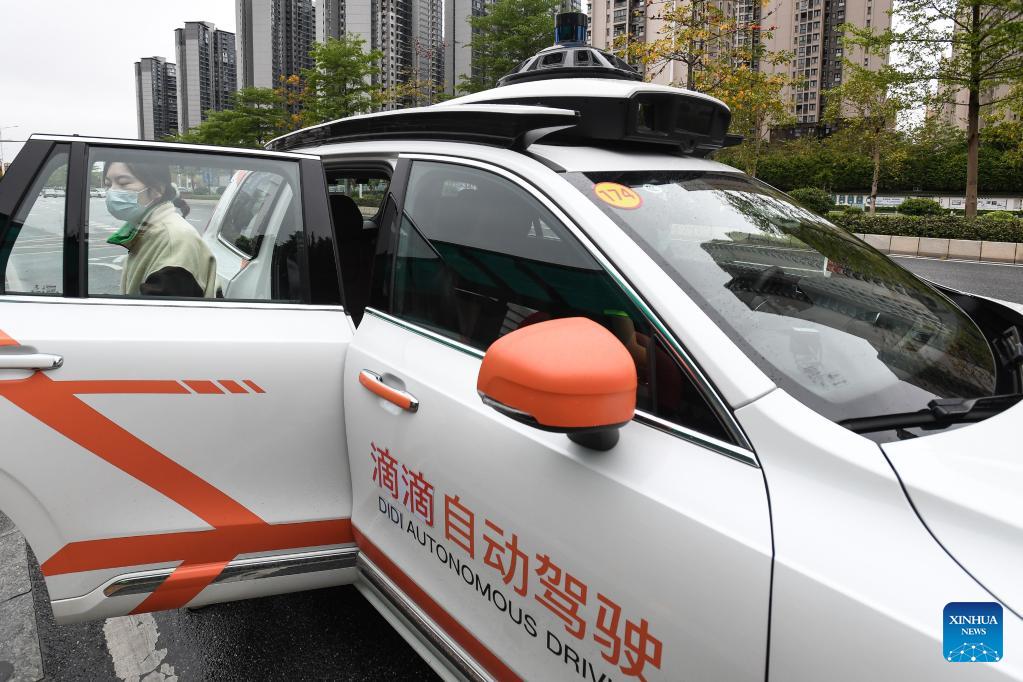
 0 Comment(s)
0 Comment(s) Print
Print E-mail China Daily, December 7, 2023
E-mail China Daily, December 7, 2023

Multiple sensors are installed on top of a Didi autonomous driving vehicle in Huadu District of Guangzhou, south China's Guangdong Province, March 27, 2023. [Photo/Xinhua]
A safety guideline for the use of driverless vehicles in public transportation is expected to further bolster China's leading position in the popularization and commercialization of self-driving technology, experts said.
The guideline, issued on Tuesday by the Ministry of Transport, applies to autonomous vehicles for both passenger and freight transportation services such as taxis, buses and trucks. It covers vehicles with various degrees of automation and mandates that they carry at least one driver or security inspector.
Autonomous vehicles for freight transportation and taxis with conditional automation systems are required to carry one driver. With the approval of local governments, fully autonomous taxis can operate in designated areas with one security inspector remotely overseeing them, the guideline said.
Security inspectors should receive professional training in self-driving technology in a timely manner, master the provisions of road traffic safety laws and regulations, and have the ability to take manual control of such vehicles in case of emergencies, according to the guideline.
It stipulated that one security inspector should not oversee more than three autonomous vehicles at a time, and that these vehicles should operate only in designated areas that have undergone road traffic safety assessment.
Self-driving technology should be used cautiously for passenger transportation services, the document said, adding that driverless buses should operate on fixed routes with simple road conditions and driverless taxis should operate in areas with good traffic conditions, where risks are more manageable.
For freight services, the technology should be employed for point-to-point highway transportation or on safe and controlled city roads. Transporting dangerous goods using autonomous vehicles is prohibited.
Operators using driverless vehicles for public transportation should be certified, and they should ensure their vehicles have eye-catching patterns, colors, signs or words to clearly inform other drivers of the vehicles' autonomous status.
The operators should also notify the passengers about the vehicles' self-driving functions, safety features and emergency escape routes through signs and videos, according to the guideline.
"The guideline is of great significance in promoting the development of autonomous buses," Bai Wenxi, chief economist at IPG China, was quoted as saying by Beijing Business Today.
Bai said the guideline will help improve public awareness and acceptance of self-driving technology, as it provides standardized operation procedures and safety measures to make driverless buses safer and more reliable, and also offers policy support and legal protection.
Pan Jun, a senior consultant at Bain & Company, said the popularity of autonomous buses might be influenced by factors such as the comprehensiveness of the legal framework and the technical standard system, market size, cost and economic efficiency.
"With continuous progress in technology and policies, autonomous buses are expected to be widely used in the near future, and even gradually replace traditional buses to become an important part of urban public transportation," Pan said.
Acknowledging the long-term prospects, China took self-driving technology as an important direction in the future transformation and upgrading of the automotive industry in 2015, and unveiled a draft strategy for innovation and development of intelligent vehicles in 2018.
The strategy was jointly issued by 11 central government departments, eliminating potential hurdles in cross-departmental collaboration in automotive, telecommunication and mapping services.
As one of the few countries to roll out policies on autonomous vehicles at the national level, China has encouraged local authorities to formulate their respective management regulations and supportive policies, and step up the application and promotion of autonomous vehicles.
As one of the pilot cities for the coordinated development of smart city infrastructure and intelligent vehicles, Shenzhen in Guangdong province issued the first regulation on intelligent vehicle management last year.
Beijing started the construction of autonomous driving pilot areas in 2020, and in 2022, launched China's first demonstration area for commercial self-driving vehicle services in the Beijing Economic-Technological Development Area, where robotaxi operators can charge fares and driverless vehicles can operate with the help of sensing devices and internet of things.